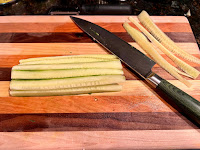You know... I've been eating cucumbers all my life, but apparently I have taken their wonderful nutritional values and benefits completely for granted. That is... until I stumbled across this article on WebMD. Read it and smile, because including more cucumber in our diabetic meal plans is not only easy, but quite tasty as well. I'll link to a couple of my cucumber recipes at the end, too. Enjoy!
Health Benefits of Cucumber
Medically Reviewed by Mahammad Juber, MD on
November 29, 2022
Written by WebMD Editorial
Contributors
Cucumbers are refreshing, juicy members in the gourd family
that are popular in summer dishes and salads around the world. Cucumbers thrive
in warm temperatures, making them a common addition to summertime gardens.
Their mild flavor makes them easy to add to many dishes without affecting the
flavor of the food, which makes cucumbers an easy way to add bulk to smaller
meals. Cucumbers can also be pickled, and they pick up the flavor of the brine
better than almost any other green thing. Cucumbers are technically considered
berries, not vegetables. However, their green skin still offers some
significant health benefits, as does the rest of the cucumber.
Health Benefits
The vitamins, minerals, and antioxidants in cucumber provide
significant health benefits. For example, cucumber skin is full of beta-carotene,
which is part of the reason for its rich green color. The carotene family of
pigments are important provitamins.
Your body can convert beta-carotenes into vitamin A,
which is a critical vitamin for keeping your eyes and skin healthy.
Other health benefits of cucumber include:
Cucumber is a super-low calorie food.
An entire cucumber, generally defined as being 8.25 inches long or 300 grams,
only has 45 calories. Cucumbers are more than 96% water, so they’re filling and
nutritious but not calorie-dense. This high-water, low-calorie combination is
great for weight management. Studies have shown that eating foods with low
energy density, or few calories per gram, is connected with weight loss in
people who are obese. Cucumbers are the very definition of a food with a low
energy density, so adding them to your diet may help you maintain or reduce
your weight.
Cucumbers are full of nutrients that act as antioxidants.
These antioxidants may have particularly powerful effects, according to some
studies. One such study tested the power of cucumber powder and found that
adding cucumber to the diet significantly increases the amount of antioxidant
activity in the body. While more studies should be done, cucumber root is a
safe way to get more dietary antioxidants easily.
Finally, cucumbers are low in carbohydrates, so they can be
a good option for people with elevated blood sugar levels. Early trials suggest
that cucumber is one of the most effective plants for not only reducing blood
sugar levels but also lowering the risk of hypoglycemia during
a blood sugar drop. For people with diabetes, cucumber may be
a helpful addition to their diet to moderate blood sugar levels more
effectively.
Nutrition
Cucumbers are full of antioxidants,
particularly in their skin. These compounds help your body process and
remove free
radicals, which lowers your risk of health conditions like cancer, heart disease,
and diabetes.
Cucumber is also rich in the mineral potassium. This mineral
helps your nerves fire, your cells communicate, your muscles contract, and your
kidneys function. Without enough potassium, you may start to notice problems
with your blood pressure and heart function.
In addition to antioxidants and potassium, cucumber is an
excellent source of:
Nutrients per Serving
A 1/2-cup serving of cucumber contains:
- Calories: 8
- Protein: Less than 1 gram
- Fat: Less than 1 gram
- Carbohydrates: 2 grams
- Fiber: Less than 1 gram
- Sugar: 1 gram
Portion Sizes
Because cucumber is so low in calories, it’s hard to eat too
much when it comes to weight management. However, eating too much of anything
can cause discomfort. Eating large amounts of cucumber in one sitting may lead
to stomach pain or distress. In general, it’s best to eat a few ounces of
cucumber at a time to prevent stomach discomfort.
How to Prepare Cucumber
Cucumber is a versatile food. It’s easily found in grocery
stores, farmers’ markets, and health food stores around the country all year
long, though it may be less expensive during the summer when it’s in
season.
Cucumbers are most frequently eaten raw. Their high water
content can cause strange results when they are incorporated into cooked
dishes. As a result, cucumbers are most commonly eaten cold. Here are a few
ways to incorporate this refreshing plant into your diet.
- Sprinkle sliced cucumbers with salt as a snack.
- Eat a small cucumber on its own.
- Add cucumber slices to water.
- Include cucumbers in salads.
- Make your own pickles.
- Add cucumbers to sandwiches.
- Throw cucumber slices into smoothies.
As promised, here are a few of my favorite ways to use cucumber:
Have a great week, everyone, and thank you for your support!
Blessed be… and happy cooking!
Chef Michael R









































.jpg)


















